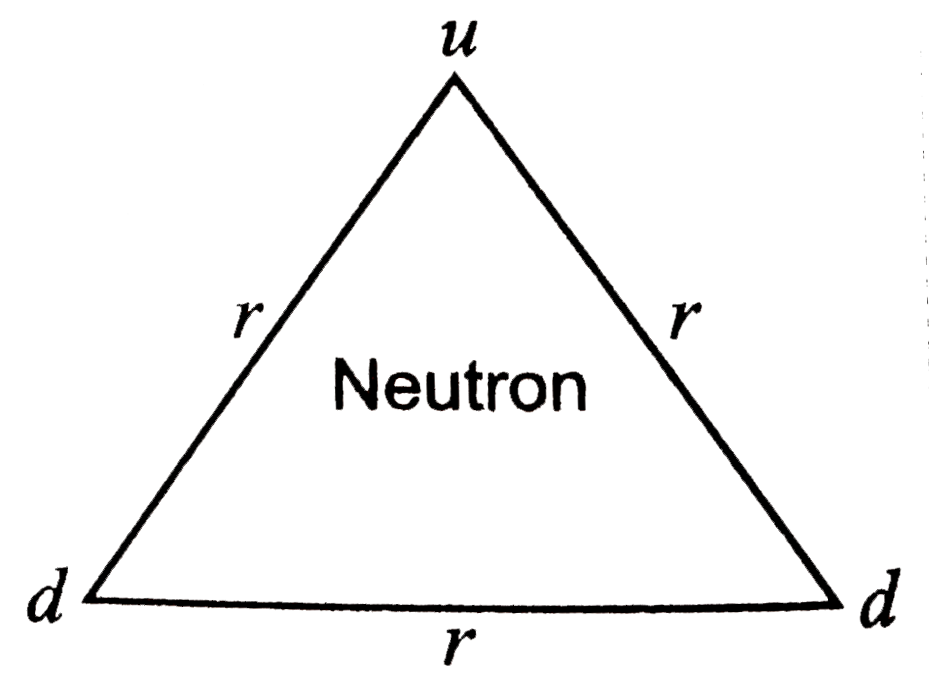Quarks iinside protons and neutrons are thought to carry fractional charges [(+2/3)e,(−1/3)e]. Why do they not show up in Millikan's oil-drop experiment ?
Quarks are thought to be confined within a proton or neutron by means of forces which grow stronger if one tries to pull them apart. Therefore, fractional, charges +23eand−13e exist in nature, but observable charges are still ±e or their integer multiples. so, charges of quarks do not show up in Millikan.s oil drop experiment.
Topper's Solved these Questions
- DUAL NATURE OF RADIATION AND MATTERBOOK - U-LIKE SERIESCHAPTER - DUAL NATURE OF RADIATION AND MATTEREXERCISE - CASE BASED/SOURCE-BASED INTEGRATED QUESTIONS
10 Videos
- DUAL NATURE OF RADIATION AND MATTERBOOK - U-LIKE SERIESCHAPTER - DUAL NATURE OF RADIATION AND MATTEREXERCISE - MULTIPLE CHOICE QUESTIONS
30 Videos
- DUAL NATURE OF RADIATION AND MATTERBOOK - U-LIKE SERIESCHAPTER - DUAL NATURE OF RADIATION AND MATTEREXERCISE - SELF ASSESSMENT TEST SECTION-C (VERY SHORT ANSWER QUESTIONS)
3 Videos
- CURRENT ELECTRICITY BOOK - U-LIKE SERIESCHAPTER - CURRENT ELECTRICITY EXERCISE - SELF ASSESSMENT TEST (SECTION C )
3 Videos
- ELECTRIC CHARGES AND FIELDS BOOK - U-LIKE SERIESCHAPTER - ELECTRIC CHARGES AND FIELDS EXERCISE - SELF ASSESSMENT TEST (SECTION-B) (VERY SHORT ANSWER QUESTIONS)
4 Videos
Similar Questions
Answer the following questions:
(a) Quarks inside protons and neutrons are thought to carryfractional charges [(+2/3)e , (–1/3)e]. Why do they not show up in Millikan’s oil-drop experiment?
(b) What is so special about the combination e/m? Why do we not simply talk of e and m separately?
(c) Why should gases be insulators at ordinary pressures and start conducting at very low pressures?
(d) Every metal has a definite work function. Why do all photoelectrons not come out with the same energy if incident radiation is monochromatic? Why is there an energy distribution of photoelectrons?
(e) The energy and momentum of an electron are related to the frequency and wavelength of the associated matter wave by the relations:
E = h ν, p = λh
But while the value of λ is physically significant, the value of ν (and therefore, the value of the phase speed ν λ) has no physical significance. Why?
View SolutionAnswer the following questions:
(a) Quarks inside protons and neutrons are thought to carryfractional charges [(+2/3)e , (–1/3)e]. Why do they not show up in Millikan’s oil-drop experiment?
(b) What is so special about the combination e/m? Why do we not simply talk of e and m separately?
(c) Why should gases be insulators at ordinary pressures and start conducting at very low pressures?
(d) Every metal has a definite work function. Why do all photoelectrons not come out with the same energy if incident radiation is monochromatic? Why is there an energy distribution of photoelectrons?
(e) The energy and momentum of an electron are related to the frequency and wavelength of the associated matter wave by the relations:
E = h ν, p = λh
But while the value of λ is physically significant, the value of ν (and therefore, the value of the phase speed ν λ) has no physical significance. Why?
View Solution
Knowledge Check
If gE and gM are the acceleration due to gravity on the surfaces of the earth and the moon respectively and if Millikan's oil drop experiment could be performed on the two surfaces, one will find the ratio ("electronic charge on the moon")/("electronic charge on the earth") to be
A1BzeroCgEgMDgMgEIf gE and gM are the acceleration due to gravity on the surfaces of the earth and the moon respectively and if Millikan's oil drop experiment could be performed on the two surfaces, one will find the ratio ("electronic charge on the moon")/("electronic charge on the earth") to be
A1BzeroCgEgMDgMgEIf gE and gM are the acceleration due to gravity on the surfaces of the earth and the moon respectively and if Millikan's oil drop experiment could be performed on the two surfaces, one will find the ratio
electronic charge on the moon/electronic charge on the earth to beA(a) gM/gEB(b) 1C(c) 0D(d) gE/gM
If gE and gM are the acceleration due to gravity on the surfaces of the earth and the moon respectively and if Millikan's oil drop experiment could be performed on the two surfaces, one will find the ratio
electronic charge on the moon/electronic charge on the earth to be
View Solution(a) In a quark model of elementary particles, a neutron is made of one up quarks [charge (2/3)e] and two down quarks [charges - (1/3)e].As∑etˆtheyhavea△configurationwiths≤n>hoftheorderof10^(-15) m. Calculate electrostatic potential energy of neutron and compare it with its mass 939 MeV.
(b) Repeat above exercise for a proton which is made of two up and one down quark.

View Solution(a) In a quark model of elementary particles, a neutron is made of one up quarks [charge (2/3)e] and two down quarks [charges - (1/3)e]. Assume that they have a triangle configuration with side length of the order of 10−15m. Calculate electrostatic potential energy of neutron and compare it with its mass 939 MeV.
(b) Repeat above exercise for a proton which is made of two up and one down quark.

View SolutionAn oil drop of 10 excess electron is held stationary under a consatnt electric field of 3.6×104NC−1 in Millikan's oil drop experiment. The density of oil is 1.26gcm−3. Radius of the oil drop is
(Take, g=9.8ms−2,e=1.6×10−19C)
View SolutionAn oil drop of 10 excess electron is held stationary under a consatnt electric field of 3.6×104NC−1 in Millikan's oil drop experiment. The density of oil is 1.26gcm−3. Radius of the oil drop is
(Take, g=9.8ms−2,e=1.6×10−19C)
View Solution
